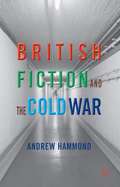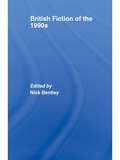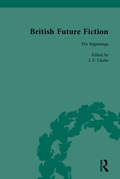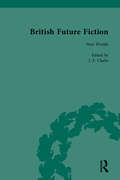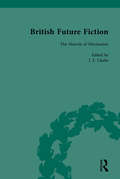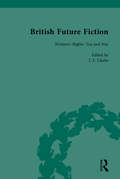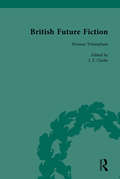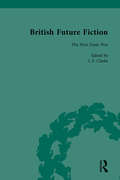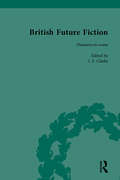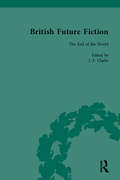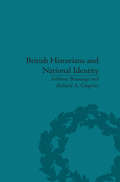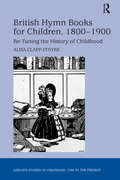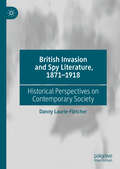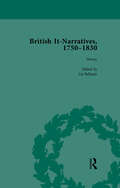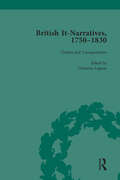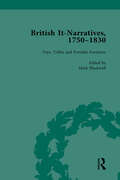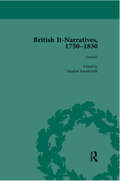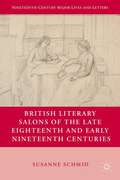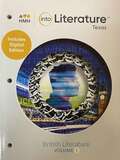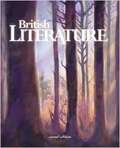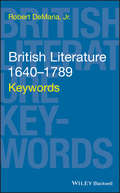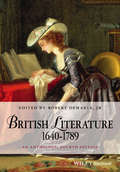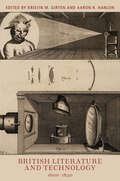- Table View
- List View
British Fiction and the Cold War
by Andrew HammondThis book offers a unique analysis of the wide-ranging responses of British novelists to the East-West conflict. Hammond analyses the treatment of such geopolitical currents as communism, nuclearism, clandestinity, decolonisation and US superpowerdom, and explores the literary forms which writers developed to capture the complexities of the age.
British Fiction of the 1990s
by Nick BentleyThe 1990s proved to be a particularly rich and fascinating period for British fiction. This book presents a fresh perspective on the diverse writings that appeared over the decade, bringing together leading academics in the field. British Fiction of the 1990s: traces the concerns that emerged as central to 1990s fiction, in sections on millennial anxieties, identity politics, the relationship between the contemporary and the historical, and representations of contemporary space offers distinctive new readings of the most important novelists of the period, including Martin Amis, Beryl Bainbridge, Pat Barker, Julian Barnes, A.S. Byatt, Hanif Kureishi, Ian McEwan, Iain Sinclair, Zadie Smith and Jeanette Winterson shows how British fiction engages with major cultural debates of the time, such as the concern with representing various identities and cultural groups, or theories of ‘the end of history’ discusses 1990s fiction in relation to broader literary and critical theories, including postmodernism, post-feminism and postcolonialism. Together the essays highlight the ways in which the writing of the 1990s represents a development of the themes and styles of the post-war novel generally, yet displays a range of characteristics distinct to the decade.
British Future Fiction, 1700-1914, Volume 1: Woman Triumphant
by I F ClarkeThis set of eight volumes presents the reader with selected primary texts in the genre now generally known as future fiction. The chosen texts are designed to explore the dominant characteristics of the genre and examine how it changed over the 18th and 19th centuries.
British Future Fiction, 1700-1914, Volume 2: Woman Triumphant
by I F ClarkeThis set of eight volumes presents the reader with selected primary texts in the genre now generally known as future fiction. The chosen texts are designed to explore the dominant characteristics of the genre and examine how it changed over the 18th and 19th centuries.
British Future Fiction, 1700-1914, Volume 3: Woman Triumphant
by I F ClarkeThis set of eight volumes presents the reader with selected primary texts in the genre now generally known as future fiction. The chosen texts are designed to explore the dominant characteristics of the genre and examine how it changed over the 18th and 19th centuries.
British Future Fiction, 1700-1914, Volume 4: Woman Triumphant
by I F ClarkeThis set of eight volumes presents the reader with selected primary texts in the genre now generally known as future fiction. The chosen texts are designed to explore the dominant characteristics of the genre and examine how it changed over the 18th and 19th centuries.
British Future Fiction, 1700-1914, Volume 5: Woman Triumphant
by I F ClarkeThis set of eight volumes presents the reader with selected primary texts in the genre now generally known as future fiction. The chosen texts are designed to explore the dominant characteristics of the genre and examine how it changed over the 18th and 19th centuries.
British Future Fiction, 1700-1914, Volume 6: Woman Triumphant
by I F ClarkeThis set of eight volumes presents the reader with selected primary texts in the genre now generally known as future fiction. The chosen texts are designed to explore the dominant characteristics of the genre and examine how it changed over the 18th and 19th centuries.
British Future Fiction, 1700-1914, Volume 7: Woman Triumphant
by I F ClarkeThis set of eight volumes presents the reader with selected primary texts in the genre now generally known as future fiction. The chosen texts are designed to explore the dominant characteristics of the genre and examine how it changed over the 18th and 19th centuries. This is Volume 7. Disasters-to-Come.
British Future Fiction, 1700-1914, Volume 8: Woman Triumphant
by I F ClarkeThis set of eight volumes presents the reader with selected primary texts in the genre now generally known as future fiction. The chosen texts are designed to explore the dominant characteristics of the genre and examine how it changed over the 18th and 19th centuries.
British Historians and National Identity: From Hume to Churchill
by Anthony Leon BrundageTwo eminent scholars of historiography examine the concept of national identity through the key multi-volume histories of the last two hundred years. Starting with Hume’s History of England (1754–62), they explore the work of British historians whose work had a popular readership and an influence on succeeding generations of British children.
British Hymn Books for Children, 1800-1900: Re-Tuning the History of Childhood (Studies in Childhood, 1700 to the Present)
by Alisa Clapp-ItnyreExamining nineteenth-century British hymns for children, Alisa Clapp-Itnyre argues that the unique qualities of children's hymnody created a space for children's empowerment. Unlike other literature of the era, hymn books were often compilations of many writers' hymns, presenting the discerning child with a multitude of perspectives on religion and childhood. In addition, the agency afforded children as singers meant that they were actively engaged with the text, music, and pictures of their hymnals. Clapp-Itnyre charts the history of children’s hymn-book publications from early to late nineteenth century, considering major denominational movements, the importance of musical tonality as it affected the popularity of hymns to both adults and children, and children’s reformation of adult society provided by such genres as missionary and temperance hymns. While hymn books appear to distinguish 'the child' from 'the adult', intricate issues of theology and poetry - typically kept within the domain of adulthood - were purposely conveyed to those of younger years and comprehension. Ultimately, Clapp-Itnyre shows how children's hymns complicate our understanding of the child-adult binary traditionally seen to be a hallmark of Victorian society. Intersecting with major aesthetic movements of the period, from the peaking of Victorian hymnody to the Golden Age of Illustration, children’s hymn books require scholarly attention to deepen our understanding of the complex aesthetic network for children and adults. Informed by extensive archival research, British Hymn Books for Children, 1800-1900 brings this understudied genre of Victorian culture to critical light.
British Hymn Books for Children, 1800-1900: Re-Tuning the History of Childhood (Studies in Childhood, 1700 to the Present)
by Alisa Clapp-ItnyreExamining nineteenth-century British hymns for children, Alisa Clapp-Itnyre argues that the unique qualities of children's hymnody created a space for children's empowerment. Unlike other literature of the era, hymn books were often compilations of many writers' hymns, presenting the discerning child with a multitude of perspectives on religion and childhood. In addition, the agency afforded children as singers meant that they were actively engaged with the text, music, and pictures of their hymnals. Clapp-Itnyre charts the history of children’s hymn-book publications from early to late nineteenth century, considering major denominational movements, the importance of musical tonality as it affected the popularity of hymns to both adults and children, and children’s reformation of adult society provided by such genres as missionary and temperance hymns. While hymn books appear to distinguish 'the child' from 'the adult', intricate issues of theology and poetry - typically kept within the domain of adulthood - were purposely conveyed to those of younger years and comprehension. Ultimately, Clapp-Itnyre shows how children's hymns complicate our understanding of the child-adult binary traditionally seen to be a hallmark of Victorian society. Intersecting with major aesthetic movements of the period, from the peaking of Victorian hymnody to the Golden Age of Illustration, children’s hymn books require scholarly attention to deepen our understanding of the complex aesthetic network for children and adults. Informed by extensive archival research, British Hymn Books for Children, 1800-1900 brings this understudied genre of Victorian culture to critical light.
British Invasion and Spy Literature, 1871–1918: Historical Perspectives on Contemporary Society
by Danny Laurie-FletcherThis book examines British invasion and spy literature and the political, social, and cultural attitudes that it expresses. This form of literature began to appear towards the end of the nineteenth century and developed into a clearly recognised form during the Edwardian period (1901-1914). By looking at the origins and evolution of invasion literature, and to a lesser extent detective literature, up to the end of World War I, Danny Laurie-Fletcher utilises fiction as a window into the mind-set of British society. There is a focus on the political arguments embedded within the texts, which mirrored debates in wider British society that took place before and during World War I – debates about military conscription, immigration, spy scares, the fear of British imperial decline, and the rise of Germany. These debates and topics are examined to show what influence they had on the creation of the intelligence services, MI5 and MI6, and how foreigners were perceived in society.
British It-Narratives, 1750-1830, Volume 1
by Liz Bellamy Christina Lupton Mark Blackwell Heathe KeenleysideIt-narratives are prose fictions that take as their central characters animals or inanimate objects. This four-volume reset collection includes numerous examples of narratives in different forms, including short stories, excerpts from novels, periodical fiction and serialized works.
British It-Narratives, 1750-1830, Volume 3
by Liz Bellamy Christina Lupton Mark Blackwell Heathe KeenleysideIt-narratives are prose fictions that take as their central characters animals or inanimate objects. This four-volume reset collection includes numerous examples of narratives in different forms, including short stories, excerpts from novels, periodical fiction and serialized works.
British It-Narratives, 1750-1830, Volume 4
by Liz Bellamy Christina Lupton Mark Blackwell Heathe KeenleysideIt-narratives are prose fictions that take as their central characters animals or inanimate objects. This four-volume reset collection includes numerous examples of narratives in different forms, including short stories, excerpts from novels, periodical fiction and serialized works.
British It-Narratives, 1750�1830, Volume 2
by Liz Bellamy Christina Lupton Mark Blackwell Heathe KeenleysideIt-narratives are prose fictions that take as their central characters animals or inanimate objects. This four-volume reset collection includes numerous examples of narratives in different forms, including short stories, excerpts from novels, periodical fiction and serialized works.
British Literary Salons Of The Late Eighteenth And Early Nineteenth Centuries
by Susanne SchmidDuring the late eighteenth and early nineteenth centuries, British salons were veritable hothouses of political and cultural agitation, with renowned guests such as Byron, Moore, Thackeray, and Baillie. In this comprehensive study of the British salon, Susanne Schmid traces the activities of threesalonni#65533;res: Mary Berry, Lady Holland, and the Countess of Blessington. Mapping out the central place these circles held in London, this study explains to what extent they shaped intellectual debate and publishing ventures. Using a large number of sources — diaries, letters, silver-fork novels, satires, travel writing,Keepsakes, and imaginary conversations — the book establishes sociable networks of days gone by.
British Literature: Volume 1; Grade 12 (HMH into Literature, Texas Edition)
by Kylene Beersinto Literature, Texas Edition, British Literature; Volume 1; Grade 12
British Literature
by Ronald HortonBritish Literature (2nd ed.) discusses literature selections and cultural issues from eight literary periods in light of Scripture: Old English, Middle English, Tudor, Stuart, Neoclassical, Romantic, Victorian, and Modern. Traces English Christianity from its beginning to the present and studies the Shakespearean drama Macbeth.
British Literature 1640-1789: Keywords (Keywords in Literature and Culture (KILC).)
by Robert DeMaria Jr.An indispensable reference for scholars and students of eighteenth-century English literature This addition to the celebrated Wiley-Blackwell Keywords series explores the meanings of fifty-eight of the most important words in British literature of the period 1640-1789. Professor DeMaria focuses on words used with frequency and urgency throughout the works of most major and several minor writers of the British Neoclassical era, with the occasional reach back to the early seventeenth century for a definitive usage found in Francis Bacon, for instance, and look forward to the nineteenth century to the works of Wordsworth, Austen, and Keats. Through discussions of words such as atom, economy, humanity, labor, machine, slavery, society, and system he reveals underlying assumptions about the way writers of the period thought about the physical and social world. Likewise, considerations of words such as happiness, passion, truth, and virtue shed light on the ethical and moral commitments of the age. Unlike dictionaries and many big-data semantics projects, this book brings forth the ambiguities, nuances, and ironies that accrued to word usages during the period through a heightened awareness of the contexts in which they occurred. Highlights and exposes the salient cultural and literary debates and metamorphic moments of cultural thought Reveals an increase in irony and a decrease in allegorical usage as an important trend in the evolution of literary language during the Neoclassical period Stresses the contexts within which words or phrases appear in order to offer a fuller understanding of their meanings and significance than available from digital databases Draws upon a vast compilation of sources from one of the most transformative eras of English literature Rigorous in its scholarship and historical reach, British Literature 1640-1789: Keywords is an indispensable resource which scholars and students of British Neoclassical literature will want to keep close at hand. It is certain to become a fixture of most university reference libraries.
British Literature 1640-1789: An Anthology (Blackwell Anthologies)
by Robert DeMaria Jr.Spanning the period from the British Civil War to the French Revolution, the fourth edition of this successful anthology increases its coverage of canonical writings, plays, and of the development of British Literature in the American colonies. A thoroughly updated new edition of this popular anthology which focuses firmly on the eighteenth century without neglecting the seventeenth century Contains new texts including the play Rover by Aphra Behn, and Beggars' Opera by John Gay; increased canonical works, including works by Dryden, Pope, and Johnson; and historical contextual materials, with particualr attention to the Americas Features updated introductions throughout, taking into acccount recent critical works and editions Includes useful resources such as an alternative list of contents by theme, and a chronolgy of literary and political events, providing valuable historical and cultural context
British Literature and Technology, 1600-1830 (Aperçus: Histories Texts Cultures)
by Kristin M. Girten Aaron R. Hanlon Laura Francis Erik L. Johnson Thomas A. Oldham Zachary M. Mann Kevin MacDonnell Emily M. West Deven M. Parker Jamison Kantor Joseph DruryEnlightenment-era writers had not yet come to take technology for granted, but nonetheless were—as we are today—both attracted to and repelled by its potential. This volume registers the deep history of such ambivalence, examining technology’s influence on Enlightenment British literature, as well as the impact of literature on conceptions of, attitudes toward, and implementations of technology. Offering a counterbalance to the abundance of studies on literature and science in seventeenth- and eighteenth-century Britain, this volume’s focus encompasses approaches to literary history that help us understand technologies like the steam engine and the telegraph along with representations of technology in literature such as the “political machine.” Contributors ultimately show how literature across genres provided important sites for Enlightenment readers to recognize themselves as “chimeras”—“hybrids of machine and organism”—and to explore the modern self as “a creature of social reality as well as a creature of fiction.”
British Literature For Christian Schools
by Ronald Arthur HortonTraces the development of English literature from the early Middle Ages to the early twentieth century including examples of poems, essays, plays, short stories, and religious writings.
